AMD Announces Radeon Crimson Driver Branding & New Settings Control Panel
by Ryan Smith on November 2, 2015 10:00 AM EST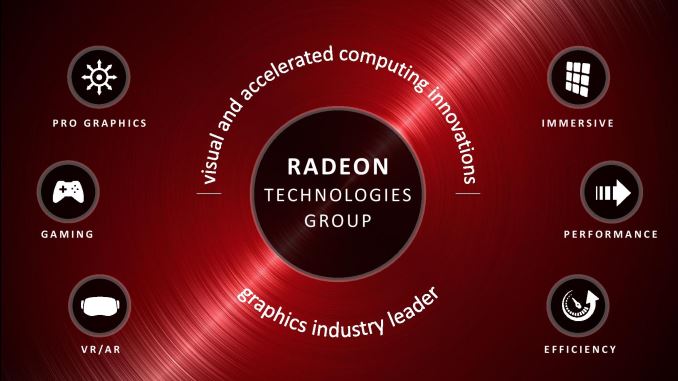
It was just under two months ago that AMD announced the major restructuring of their graphics division, which would see the graphics division made whole once again, more than 5 years after AMD first split it up to better align with their CPU division. Placed under the control of AMD veteran Raja Koduri, it would be the responsibility of Raja and the rest of the Radeon Technologies Group to take AMD’s GPU division in a new direction and to rebuild it after the struggles of the past half-decade.
Today AMD is unveiling the first real initiative to take place under the Radeon Technologies Group banner, and that is a major rebranding of AMD’s GPU drivers and a ground-up replacement of the included control panel. At the same time, as this is the first RTG initiative, AMD and the RTG are using this occasion as their first opportunity to address the public as the Radeon Technologies Group. Typically I prefer to avoid ascribing large efforts to any one person, but in this case I think it’s safe to say that there’s a clear element of Raja making his mark on the RTG, and a desire to show how he is going to run things differently than AMD has in previous years. So for as much as today is about drivers and control panels, for the RTG today is also about the group laying out their plans for the future.
But first, let’s start with the drivers. After 13 years as the Catalyst Control Center – a name that pre-dates the AMD purchase altogether – AMD is finally doing away with the Catalyst branding. In fact, in some ways AMD is doing away with permanent driver branding altogether. Beginning with the next driver release, the Radeon drivers will be known as “Radeon Software.”
At the same time, similar to projects such as Ubuntu Linux and Android, AMD will be introducing a codename-like middle name to denote the “major version.” These names, which only fitting for the RTG will all be variations of red, will start with “Crimson Edition” and will change roughly every year as AMD introduces what they consider a new major version of the software.
Finally, AMD will be retaining their existing year-dot-month version numbering scheme for these drivers, which will now indicate what AMD considers minor versions of the software. The end result will be that the full name of a driver release will be along the lines of “Radeon Software Crimson Edition 15.11,” which will be the name of the forthcoming November driver release.
Meanwhile, along with announcing the new name for their drivers, AMD has also clarified their driver release plans over the next year, which will be fairly similar to how things have been for the past year. AMD is aiming to find a balance on WHQL driver releases – not too many and not too few – and have told us to expect multiple WHQL releases per year, likely averaging a release every couple of months. Meanwhile in between those releases AMD will publish beta driver updates as they do now on an as-needed basis. Both AMD and NVIDIA have been wrangling with the desire to balance driver update release schedules with the need to avoid making their non-gaming customers update their drivers every two weeks, and for AMD the solution will continue to be to space out beta releases between major WHQL releases. And no, they tell us, you won’t need to register with them to download the new drivers.
Moving on, launching as part of the first Radeon Software release will be the company’s new control panel, which they are calling Radeon Settings. Radeon Settings will be a ground-up redesign for AMD, with the company ditching the entire Catalyst .NET codebase. In its place AMD has built a new control panel from scratch based on the QT framework (ed: this will only be for Windows, at least for now), with the goal of giving their control panel a rather significant visual overhaul while also addressing load time complaints that go back to the earliest days of the .NET control panel.
In terms of a visual style, AMD tells us that they are aiming for a much more intuitive design for Radeon Settings, and have brought in a new UI designer as part of the process. From the screenshots AMD has shared with us so far (the press was not given a preview copy ahead of today’s announcement), besides the ever-present use of brushed metal, perhaps the biggest change is that Radeon Settings is wider than it is all, and the overall style is vaguely similar to Windows Metro/Modern with a focus on large buttons as opposed to lists and drop-down menus. It is, if nothing else, much more graphical than Catalyst Control Center is.
As for functionality changes, while feature updates are chiefly the domain of the drivers rather than the control panel, Radeon Settings will bring with it a couple of notable additions for gamers. Along with their existing functionality, per-game settings profiles can now contain individual settings for Crossfire, Overdrive, Framerate Target Control, and the Shader Cache, the first three features previously only being available globally and the latter being a new option entirely. Meanwhile under the Display settings, AMD is adding an Eyefinity “Quick Setup” option that will attempt a best-guess effort to arrange and enable an Eyefinity setup with a single click, allowing users to avoid the longer full setup routine when it’s not needed. Finally, after removing it a couple of years prior due to a security issue, AMD will be bringing back the driver update functionality of their control panel, allowing Radeon Settings to check for updates and to notify the user when an update is found.
At this point AMD tells us that the first release of the Radeon Software drivers and Radeon Settings control panel will be in Q4. However I expect that we may see it a bit sooner than that, and that AMD is shooting for November while offering a conservative ETA.
Going forward, AMD has also told us that this will be the first of multiple updates on the Radeon Software, AMD’s developer relations efforts, and the overall Radeon ecosystem. At this point AMD is setting up to execute on a multi-year plan, beginning with what the company feels is a need to be seen as being serious about software. As part of that effort the company is preparing new driver features for users, and though only briefly mentioned in passing, the new Radeon Software will ultimately bring new features for developers as well. In both cases AMD is being tight-lipped at the moment, but the messaging from the company is that they will have more to discuss on the matter later this year.


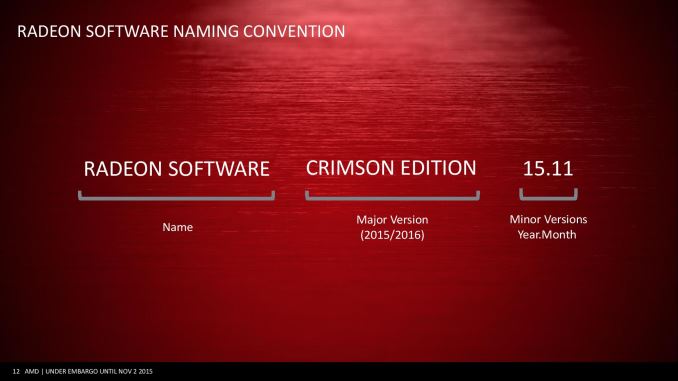
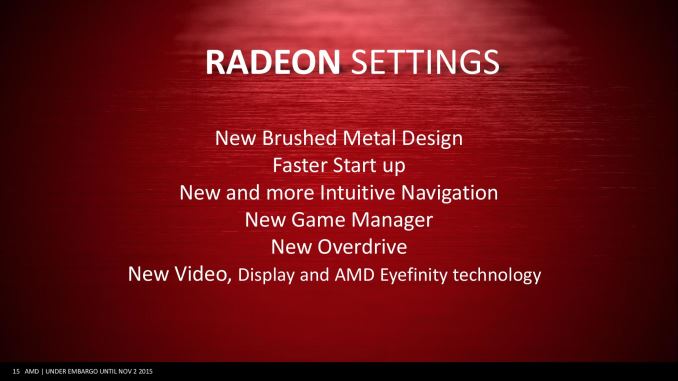
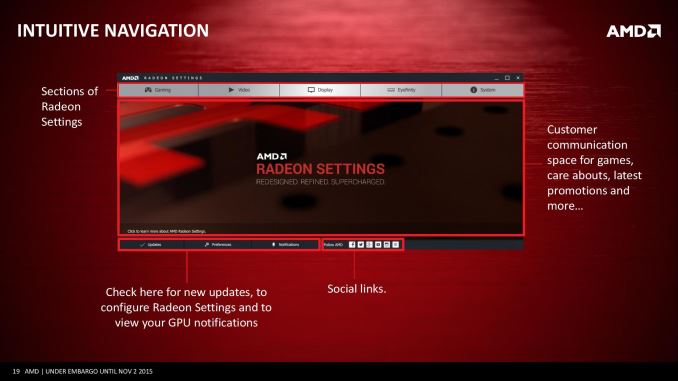
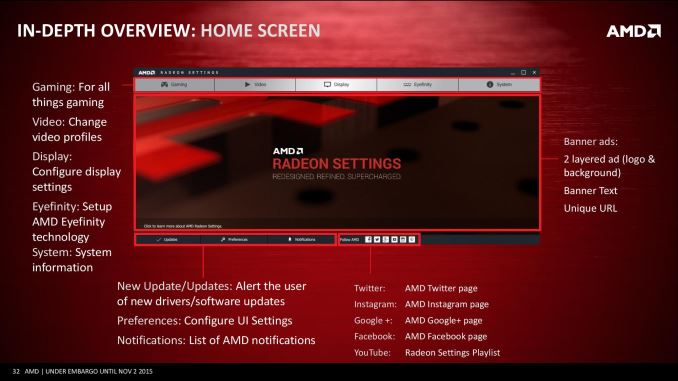
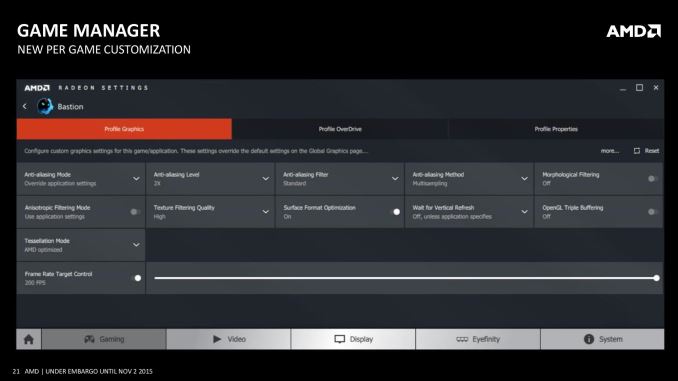
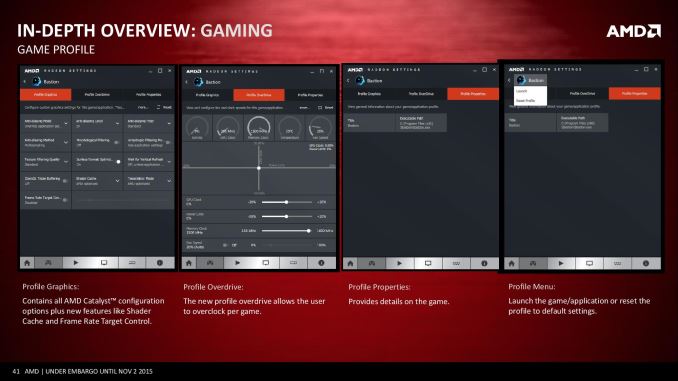














88 Comments
View All Comments
Bateluer - Monday, November 2, 2015 - link
AMD has been ahead of Nvidia, actually, for several years now. Nvidia's been throwing in more and more proprietary tech into their drivers, driving them down even further.fireduckzilla - Monday, November 2, 2015 - link
@Bateluer - I don't know what AMD drivers you've been using - but I've got a 295x2, and the number of times its crashed because of terrible drivers, or things have become unplayable is ridiculous. When Dragon Age 3 came out - I swapped out to a GTX 770 and actually got better FPS. Its been nothing but strife - I'm going back to SLI Nvidia with the next generation - Hell, if the 980ti comes down a little more in price I might jump ship early. It's ridiculous that a company would even consider writing driver control panels in .NET; Performance is key - and they used one of the slowest programming languages!?Well played AMD for pulling the wool over my eyes this time - but never again.
twnznz - Monday, November 2, 2015 - link
It's not the product, it's you. I have a 5970 still in production, which had very few issues despite being a dual-GPU-on-a-card product. You either had a broken registry, a bad CPU, or something else wrong.AMD is ahead of NVIDIA driver-wise /ignoring/ the frontend. You can see they're still working hard behind the scenes when they released the first production-worthy DX12 driver which Ars documented back in August. You can also see their contribution to Open Source with their OSS kernel module, and their commitment to opening the drivers, contributing to 'Radeon' and deprecating FGLRX.
NVidia, meanwhile, deserves the Linus Torvalds Finger.
Michael Bay - Monday, November 2, 2015 - link
And still AMD drivers on loonix are abysmal, especially compared to nV. Not that anyone sane even cares about them being open or closed-source.eek2121 - Monday, November 2, 2015 - link
I just want to throw my 2 cents in and say that AMD drivers have been extremely stable for me. I game with friends every friday (all with nvidia hardware) and they often crash at least once during our session. Typically while alt tabbing or streaming. I don't have these issues with AMD. I alt tab AND stream.Morawka - Monday, November 2, 2015 - link
amd drivers are not even close to nvidia,, all their game ready releases are beta drivers, meanwhile nvidia's are all whql certified.It is well known nvidia's directx 11 driver optimizations are second to none, it's even admitted here on anandtech.
All of this year's AAA releases are using DX 11
looncraz - Tuesday, November 3, 2015 - link
I have administered fleets of machine, AMD drivers caused less problems when running and require less reconfiguration than nVidia to get things as they should be. nVidia had more cases of crashes and the, rare, system instability issue. Neither company's driver was fully better than the other, but nVidia did present more problems in use.However, driver support for new games was delivered more quickly and, yes, WHQL certification was more frequent. This really is a non-issue, though, unless you are forced to use WHQL drivers or are frequently adopting bleeding edge games that don't yet have driver support (this is actually rare, most new games work just fine with existing drivers, but better drivers leads to better performance and, sometimes, resolves issues game developers were too lazy to fix).
BurntMyBacon - Tuesday, November 3, 2015 - link
@Morawka: "..., all their game ready releases are beta drivers, meanwhile nvidia's are all whql certified."That is just a difference in philosophy. AMD doesn't think that the common user should be bothered to upgrade their driver all the time when it only affects the newest games that the common user probably isn't playing. They view the beta driver as the gamers driver. Feel free to disagree with their naming scheme or definition of beta, but I wouldn't worry too much about the whql certification in this instance.
Having spend more than a little time on both sides of the fence (concurrently I might add), I think many issues people blame on drivers are more related to actual hardware issue (not necessarily GPU) and all the crap they get on their computers from their browsing habits. I've seen a lot of stable systems with both manufacturers. I feel like ATi has the edge in the HTPC realm. Multicard setups still go to nVidia, though that gap has gotten much smaller since the release of the Radeon 2xx series. nVidia does tend to get driver optimizations for new games out sooner than ATi. Though, this was much worse before ATi started to push developer relations.
@Morawka: "It is well known nvidia's directx 11 driver optimizations are second to none, it's even admitted here on anandtech."
They are definitely faster at getting the optimizations in there. However, as I look more at the architectures, I get the feeling that their optimizations aren't so much superior, but rather their hardware architecture is well optimized for DX11. Initially I simply credited this as ATi putting too much focus on compute. However, ATi and AMD have a long had a history of pushing forward looking architectures before their time. Given some of the features that are now being used by developers, it would appear that ATi's time with mantle had them focused on low level APIs and consequently, they spend resources into areas that aren't necessarily useful to DX11 games.
@Morawka: "All of this year's AAA releases are using DX 11"
Really? All of them? Not a single DX12 game among them? With all the hype, I would have thought it would have been a bigger deal for the AAA houses if for no other reason than to check the DX12 check box. It's a good thing people swap out video cards on a yearly basis or they might get stuck with a terrible video card when DX12 hits.
Sarcasm aside you bring up a good point, the vast majority of games in the near term are still DX11 games. DX11 will be a valid code path for the foreseeable future. DX12 is not a magic bullet, though like some previous versions of DX it has some advantages that will eventually allow for substantially different gameplay than you can get with DX11 (or DX12 at the moment). While I think ATi's architecture is better suited for DX12 at the moment, the superior DX12 architectures won't come until we see how game developers figure out how they are going to use the features available.
Spunjji - Tuesday, November 3, 2015 - link
looncraz and burntmybacon are the most sane commenters in this thread so far.I have experienced all sorts of crashes and weirdness from both companies, but only with nVidia have I experienced random intermittent crashing after a driver update that GeForce Experience recommended to me. Similarly I have access to an (admittedly awful) HDTV that works fine connected to AMD cards but has never (as in, not ever) been able to run properly at native resolution without overscan on nVidia drivers.
Those edge cases aside, both companies produce decent drivers and have good products. I am currently with nVidia for SLI / GSync but am contemplating a switch to an R9 Nano at some point in the near future.
variform - Friday, November 6, 2015 - link
First clear headed post I've found here. It's also important to realize that having too many WHQL drivers is seen as a bad thing. Normal users don't like having to update things.There is also another thing to point out. NVIDIA cards rely on individual optimizations more than AMD. To put it simply this has to do with the fact that NVIDIA uses tricks like queue and compression to squeeze more performance out of less "muscle" and power. NVIDIA cards often perform abysmally when using old drivers with new games. AMD is less impacted by this